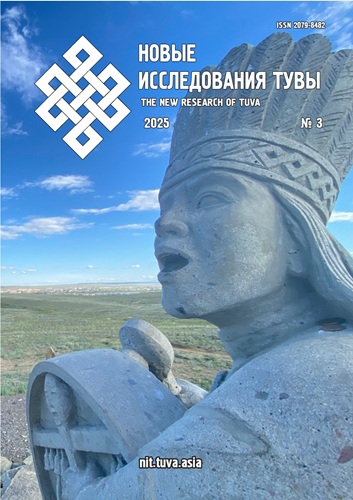Religiosity in the Mirror of Ethnic and Gender Identity Among Russians, Tuvans, and Altaians (Based on Research Materials from Altai Krai, Republic of Tuva, and Altai Republic)
DOI:
https://doi.org/10.25178/nit.2025.3.18Keywords:
Religiosity; religiosity index; gender; identity; ethnicity; Republis of Tuva; Altai; Altai Krai; Altai Republic; Tuvans; Altaians; Russians of Tuva; Russians of AltaiAbstract
The article assesses the religiosity of men and women in relation to their ethnic and confessional identification within three South Siberian regions of Russia: Altai Krai, Altai Republic, and the Republic of Tuva. The study employs the Centrality of Religiosity Scale (CRS). The religiosity of representatives of three ethnic groups (Russians, Altaians, and Tuvans) is examined from a gender analysis perspective and through the identification of five dimensions of religiosity (intellectual, ideological, public and private religious practices, religious experience). The analysis draws upon data from an original sociological study conducted in 2024 in Altai Krai (n=519), Altai Republic (n=462), and Tuva (n=361).
Distinct characteristics were identified in the manifestation of religiosity and mystical feelings among men and women. A higher level of religiosity was observed among women belonging to the dominant ethnic confessions: Orthodox Russians; Tuvans, adhering to Buddhist, Shamanistic, or syncretic beliefs; and White Faith (Ak Jang) Altaians. Compared to Russian women, Tuvan and Altaian women demonstrate greater religiosity, the significance of faith constructs, and the role of the religious sphere in both internal spiritual and external secular life. The content of religiosity components reveals not only gender-based but also ethnically conditioned differences.
There is a lower prevalence of “fervent” faith among women of all ethnicities and confessions compared to men. Women's faith is generally less overtly religious, becoming especially significant at certain points in their lives. In contrast, men's expression of faith and attachment to it is more polarized, and men are more likely to publicly demonstrate their religiosity.
Russian women are significantly less likely than Tuvan and Altaian women to be confident in the presence of a guiding hand of God or a higher power. Tuvan and Altaian women, in contrast to Russians, are much more inclined to manifest themselves in the mystical and magical spheres outside of religion.
References
Bogachev, M. I. (2016) On the question of forming an integral approach to the conceptualization of religiosity. Light of Christ Enlightens Everyone: Almanac of the St. Philaret Orthodox Christian Institute, no. 18, pp. 9–26. (In Russ.)
Borisova, O. N. and Pavlyutkin, I. V. (2019) Variability of models of modern urban families with many children: revival of tradition, new marriages or network effects? Mir Rossii, no. 4, pp. 128–151. (In Russ.)
Breskaya, O. Yu. (2011) Studying religiosity: on the need for an integral approach. Sotsiologicheskie Issledovaniya, no. 12, pp. 77–87. (In Russ.)
Grishaeva, E. I. (2018) Religious identity as an unfinished project. Prospects for applying discursive approaches to sociological study of identity in Orthodox parishes. Nauchnyi Rezultat. Sociology and Management, vol. 4, no. 1, pp. 13–22. (In Russ.)
Grishina, E. A. (2019) Occult services in the consumer space of contemporary Russian society. Vestnik RGGU. Series “Philosophy. Sociology. Art Studies”, no. 4 (19), pp. 94–108. (In Russ.)
Dashkovsky, P. K., Shershneva, E. A., Bicheldei, U. P. and Mongush, A. V. (2021) Religious situation in the Republic of Tuva (according to sociological research results). New Research of Tuva, no. 2, pp. 18–34. (In Russ.) DOI: https://doi.org/10.25178/nit.2021.2.2
Divisenko, K. S. and Divisenko, O. A. (2017) Social dimension of religiosity: empirical research experience. Peterburgskaya Sotsiologiya Segodnya, no. 8, pp. 91–110. (In Russ.)
Lamazhaa, Ch. K. (2009) Social archaization of post-Soviet Tuva. Znanie. Ponimanie. Umenie, no. 2, pp. 124–129. (In Russ.)
Lamazhaa, Ch. K. (2016) Tuvan ethnicity and society in ethnosociological and anthropological studies. New Research of Tuva, no. 2, pp. 32–51. (In Russ.)
Lamazhaa, Ch. K. (2021) Tuva as a limitrophe zone: language, religion and population identification. New Research of Tuva, no. 3, pp. 178–194. (In Russ.) DOI: https://doi.org/10.25178/nit.2021.3.14
Lamazhaa, Ch. K., Bicheldei, U. P. and Mongush, A. V. (2020) Tuvan Buddhist pilgrimage: from tradition to culture. New Research of Tuva, no. 4, pp. 135–155. (In Russ.) DOI: https://doi.org/10.25178/nit.2020.4.10
Lebedev, S. D. (2020) Sociological dimension of religiosity: towards typology of main approaches. In: Sociology and Society: Traditions and Innovations in the Social Development of Regions: Proceedings of the VI All-Russian Sociological Congress, Tyumen, October 14–16, 2020, ed. by V. A. Mansurov. Tyumen, Russian Society of Sociologists. 6003 p. Pp. 4962–4979. (In Russ.) DOI: https://doi.org/10.19181/kongress.2020.584
Maksimova, S. G., Surtaeva, O. V., Omelchenko, D. A. and Velikzhanina, K. A. (2024) Religiosity of women in border regions of Russia: general characteristics and regional specifics. Society and Security Insights, vol. 7, no. 2, pp. 69–90. (In Russ.)
Maksimova, S. G., Avdeeva, G. S., Omelchenko, D. A., Atyasova, N. Yu. and Noyanzina, O. E. (2015) Civic and ethnic identity of the population of Russia’s border regions: current state features, factors and pressing issues of formation. Izvestiya Altai State University, no. 3–1 (87), pp. 175–179. (In Russ.)
Popkov, Yu. V. and Tyugashev, E. A. (2020) Tuva in the dialogue of cultures: a comparativist context. New Research of Tuva, no. 4, pp. 217–229. (In Russ.). DOI: https://doi.org/10.25178/nit.2020.4.15
Popkov, Yu. V. and Tyugashev, E. A. (2022) “Lost world”: Tuvan culture in the center-periphery interpretation of geocultural and sociocultural space. New Research of Tuva, no. 1, pp. 225–236. (In Russ.) DOI: https://doi.org/10.25178/nit.2022.1.15
Smirnov, M. Yu. (2015) Is it possible to abandon the concept of religiosity in the study of religion? Vestnik Russkoi Khristianskoi Gumanitarnoi Akademii, vol. 16, no. 2, pp. 145–153. (In Russ.)
Tovuu, N. O. (2019) Traditional belief of Tuvans: ethnic features. Professional Education in the Modern World, no. 9 (4), pp. 3356–3364. (In Russ.) DOI: https://doi.org/10.15372/PEMW20190424
Khlopkova, O. V. (2020) Transformation of approaches to the study of religiosity in social sciences. Chelovek. Socium. Obshchestvo., no. 2, pp. 122–130. (In Russ.)
Huber, Sh. and Huber, O. (2018) Centrality of Religiosity Scale (CRS) / trans. by E. V. Prutskova and K.V. Markin. Sotsiologiya: Metodologiya, Metody, Matematicheskoe Modelirovanie (Sotsiologiya:4M), no. 47, pp. 144–171. (In Russ.)
Shakhbanova, M. M. (2021) Religious identity of urban population of Dagestan in the structure of social identity. Historical and Socio-Educational Thought, vol. 13, no. 1, pp. 93–108. (In Russ.)
Ervie-Leje D. (2015) In search of certainty: paradoxes of religiosity in developed modern societies. State, Religion, Church in Russia and Abroad, no. 1 (33), pp. 254–268. (In Russ.)
Abdel-Khalek, A. and Lester, D. (2013) Mental health, subjective well-being, and religiosity: Significant associations in Kuwait and USA. Journal of Muslim Mental Health, vol. 7, issue 2, pp. 63–76. DOI: https://doi.org/10.3998/jmmh.10381607.0007.204
Acevedo, G. and Shah, S. (2015) Sectarian affiliation and gender traditionalism: A study of Sunni and Shi’a Muslims in four predominantly Muslim countries. Sociology of Islam, vol. 3, pp. 1–29. DOI: https://doi.org/10.1163/22131418-00301001
Berger, P. L. (1974) Modern identity: Crisis and continuity. In: W. S. Dillon (Ed.) The cultural drama: Modern identities and social ferment. Washington, DC., Smithsonian Institution Press. 328 p. Рp. 159–181.
Davie, G. (2004) New Approaches in the Sociology of Religion: A Western Perspective. Social Compass, no. 53, pp. 73–84. DOI: https://doi.org/10.1177/0037768604040791
de Vaus, D. and McAllister, I. (1987) Gender Differences in Religion: A Test of the Structural Location Theory. American Sociological Review, vol. 52, no. 4, pp. 472–481. DOI: https://doi.org/10.2307/2095292
Finke, R. and Adamczyk, A. (2008) Cross-National Moral Beliefs: The Influence of National Religious Context. The Sociological Quarterly, vol. 49, pp. 617–652. DOI: https://doi.org/10.1111/j.1533-8525.2008.00130.x
Glock, C. Y. (1962) On the Study of Religious Commitment. Religious Education, vol. 57, sup. 4, pp. 98–110.
Hill, P. C. and Hood, R. W. (1999) Measures of religiosity. Birmingham, Alabama, Religious Education Press. 531 р.
Huber, S., Ackert, M. and Scheiblich, H. (2020) Religiosität in unterschiedlichen Religionskulturen — Vergleiche auf der Basis der Centrality of Religiosity Scale. Cultura & Psyché, vol. 1 (1–2), pp. 171–185. DOI: https://doi.org/10.1007/s43638-020-00007-3
Lenski, G. (1961) The Religious Factor: A Sociological Study Of Religion's Impact On Politics, Economics, And Family Life. Publisher: Garden City, N. Y., Doubleday. 381 p.
Li, A. Y. C. and Liu, J. K. K. (2021) Effects of intrinsic and extrinsic religiosity on well-being through meaning in life and its gender difference among adolescents in Hong Kong: A mediation study. Current Psychology, vol. 42, pp. 7171–7181.
Ngamaba, K. H. and Soni, D. (2018) Are happiness and life satisfaction different across religious groups? Exploring determinants of happiness and life satisfaction. Journal of Religion and Health, vol. 57, no. 6, pp. 2118–2139. DOI: https://doi.org/10.1007/s10943-017-0481-2
Perveen, A., Mehmood, B. and Yasin, M. G. (2017) Materialism and life satisfaction in Muslim youth: Role of gratitude and religiosity. Pakistan Journal of Psychological Research, vol. 32, no. 1, pp. 763–771.
Reitz, A. K., Asendorpf, J. B. and Motti-Stefanidi, F. (2015) When do immigrant adolescents feel personally discriminated against? Longitudinal effects of peer preference. International Journal of Behavioral Development, vol. 39, no. 3, pp. 197–209. DOI: https://doi.org/10.1177/0165025414567008
Roberto, A., Sellon, A., Cherry, S. T., Hunter-Jones, J. and Winslow, H. (2020) Impact of spirituality on resilience and coping during the COVID-19 crisis: A mixed-method approach investigating the impact on women. Health Care for Women International, vol. 41, no. 11–12, pp. 1313–1334. DOI: https://doi.org/10.1080/07399332.2020.1832097
Stark, R. (1996) Religion as Context: Hellfire and Delinquency One More Time. Sociology of Religion, vol. 57, no. 2, pp. 151–163. DOI: https://doi.org/10.2307/3711948
Sultan, S., Kanwal, F. and Hussain, I. (2020) Moderating effects of personality traits in relationship between religious practices and mental health of university students. Journal of Religion and Health, vol. 59, no. 5, pp. 2458–2468. DOI: https://doi.org/10.1007/s10943-019-00875-x
Unterrainer, H. F., Lewis, A. J. and Fink, A. (2014) Religious/spiritual well-being, personality and mental health: A review of results and conceptual issues. Journal of Religion and Health, vol. 53, no. 2, pp. 382–392. DOI: https://doi.org/10.1007/s10943-012-9642-5
Vang, Z. M., Hou, F. and Elder, K. (2019) Perceived religious discrimination, religiosity, and life satisfaction. Journal of Happiness Studies, vol. 20, no. 6, pp. 1913–1932.
Villani, D., Sorgente, A., Iannello, P. and Antonietti, A. (2019) The role of spirituality and religiosity in subjective well-being of individuals with different religious status. Frontiers in Psychology, vol. 10, article 1525. DOI: https://doi.org/10.3389/fpsyg.2019.01525
Wixwat, M. and Saucier, G. (2021) Being spiritual but not religious. Current Opinion in Psychology, vol. 40, pp. 121–125. DOI: https://doi.org/10.1016/j.copsyc.2020.09.003
Zahoor, N., Khattak, A. Z., Amjad, M., Shaukat, S., Khanum, U. and Raziq, U. (2021) Relationship between religiosity and Life satisfaction in undergraduate students at Kohat University of Science & Technology KPK Pakistan. Journal of Professional and Applied Psychology, vol. 2, no. 1, pp. 36–42. DOI: https://doi.org/10.52053/jpap.v2i1.32
Published
How to Cite
For citation:
Noyanzina O. E., Maksimova S. G. and Omelchenko D. A. Religiosity in the Mirror of Ethnic and Gender Identity Among Russians, Tuvans, and Altaians (Based on Research Materials from Altai Krai, Republic of Tuva, and Altai Republic). New Research of Tuva, 2025, no. 3, pp. 296-316. (In Russ.). DOI: https://doi.org/10.25178/nit.2025.3.18
Issue
Section

This work is licensed under a Creative Commons Attribution-NonCommercial 4.0 International License.

Author(s) license holder(s) grant rights for their work to the journal (grantee of a license) under the simple non-exclusive open license in accordance with Art. 1286.1 «Open license for a research work, work of literature or fine arts», Civil Code of the Russian Federation.
New Research of Tuva publishes articles under the Creative Commons Attribution-NonCommercial license (CC BY-NC).
Since it is an open license, author(s) reserve the right to upload the article to their institutional repository, submit it to another journal (if it allows republications), or republish it on their own website (in full, or in part).
However, several conditions apply here:
a) The republished version must always contain the name(s) and affiliation(s) of the author(s), the original title and the hyperlink to the original version on the New Research of Tuva website;
b) It must be in open access, free of charge, and no category of readers must be in any way whatsoever advantaged over general readership.
c) should the contribution be submitted elsewhere by its author(s) without substantial modification (30% or more of original text unchanged), the body of the article should contain a disclaimer that the original version was published in New Research of Tuva (with a link to the respective page)
The CC-BY-NC is a non-revocable license which applies worldwide and lasts for the duration of the work’s copyright.











